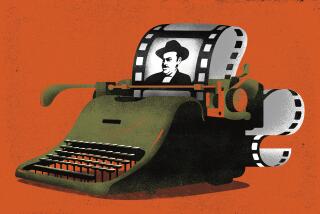‘Touch of Evil’ and its many touches of genius
A ROUTINE genre assignment that its beleaguered director turned into the most Shakespearean film noir of all time, “Touch of Evil” was primed to be Orson Welles’ comeback, the movie that revived his Hollywood career after a long period in the wilderness. Instead, this 1958 masterpiece, a vision of human fallibility as grand as it is seedy, was the last film he made for a major studio.
Welles was first hired not as director but as an actor, to play the villain in a Universal movie based on a pulp novel titled “Badge of Evil.” Charlton Heston, already attached to the film, convinced the studio that his costar, persona non grata in Hollywood after the failure of 1947’s “The Lady From Shanghai,” also could take on directing duties. Welles revised the screenplay and pulled off the shoot without a hitch.
He got through 12 pages of the script -- a complicated and claustrophobic one-take interrogation scene -- on the first day of shooting. He finished on budget and schedule, and studio heads excitedly proposed a multi-picture deal. But as tended to happen on Welles’ movies, things started to unravel in the editing.
Universal balked at what it saw -- too murky, too baroque -- and Welles lost control of the film. Reedited and padded out with additional expository scenes, “Touch of Evil” was released on the bottom half of a double bill (with a now long-forgotten Hedy Lamarr vehicle). It received tepid reviews in the States, although it was right away championed by French critics and soon-to-be-filmmakers Francois Truffaut and Jean-Luc Godard.
The film promptly sank into semi-obscurity but has been the subject of a growing cult in the decades since and now frequently is ranked alongside such Welles’ classics as “Citizen Kane” and the similarly butchered “The Magnificent Ambersons.”
All in all, “Touch of Evil” has had a happier fate than most of the other films Welles was unable to complete. The two-disc 50th-anniversary-edition DVD, released this week, brings together three key versions of the film: a preview cut, the shorter version that made it into theatrical release, and a 1998 reedit based on a detailed memo that Welles wrote to the studio. That heartbreaking 58-page document is included in the set.
Set in a shabby U.S.-Mexico border town, “Touch of Evil” plunges into its moral maze with what is now one of the most celebrated curtain-raisers in film history. A dazzling three-minute-plus crane shot follows Mexican narcotics agent Mike Vargas (Charlton Heston) and his new American bride (Janet Leigh) as they stroll through dimly lit streets and end up witnessing the bombing death of a construction tycoon. The ensuing investigation finds the newlyweds hassled and terrorized by members of the drug-running Grandi family and by the de facto ruler of this sordid little kingdom, crooked cop Hank Quinlan (Welles).
As the action shifts back and forth across the border, the film maintains a remarkable fluidity in its sensuous, prowling camerawork (Russell Metty was the cinematographer). Almost every shot is a marvel of deep-focused composition and almost every sequence features a deft bit of spatial choreography.
In more ways than one, the film belongs to Welles. His performance as the obese, game-legged, ex-alcoholic Quinlan, generally shot from below to accentuate his distended proportions, is as much a tour de force as his direction. As some critics have noted, the sweaty, oppressive physicality of the character comes to personify the film’s decadent style.
But he’s also surrounded by a gallery of vivid grotesques: Akim Tamiroff as the toupeed crime-family leader, Joseph Calleia as Quinlan’s loyal partner, Dennis Weaver as a jittery motel clerk, one of several elements that seem to foreshadow Hitchcock’s “Psycho.”
As the tarot-reading madam of a Mexican brothel, Marlene Dietrich has only a handful of scenes, but she gets all the best lines. Her flat declaration of Quinlan’s fate -- “Your future is all used up” -- has often been read as a queasy prophecy of Welles’ Hollywood career. But in the majestic final scene, she also seems to offer a casual but utterly apt tribute to her director and his troubled career: “He was some kind of man. What does it matter what you say about people?”
More to Read
Only good movies
Get the Indie Focus newsletter, Mark Olsen's weekly guide to the world of cinema.
You may occasionally receive promotional content from the Los Angeles Times.










